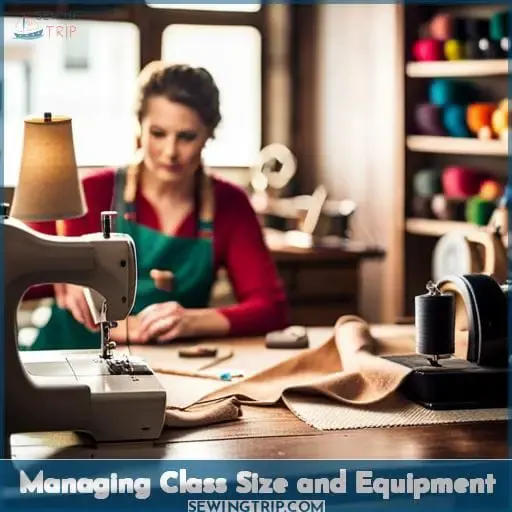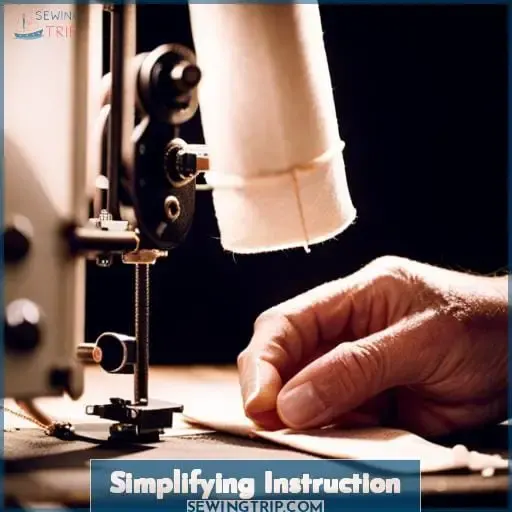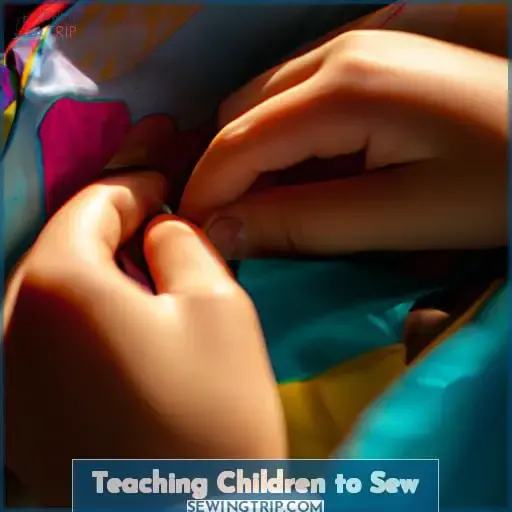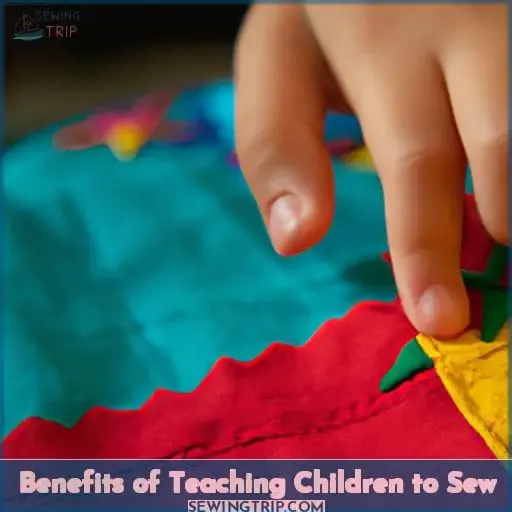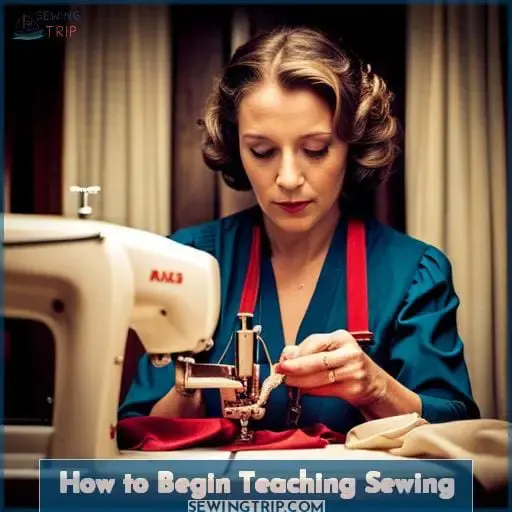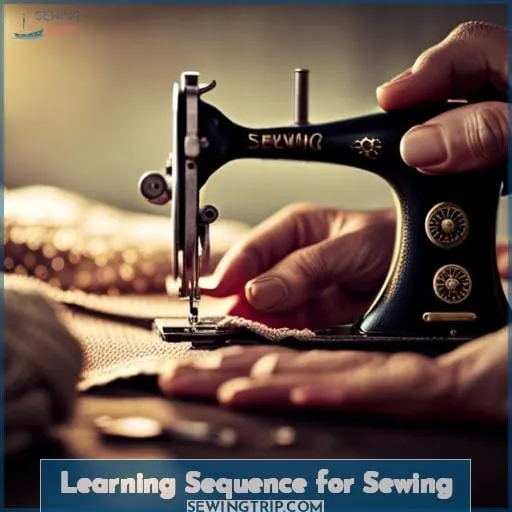This site is supported by our readers. We may earn a commission, at no cost to you, if you purchase through links.
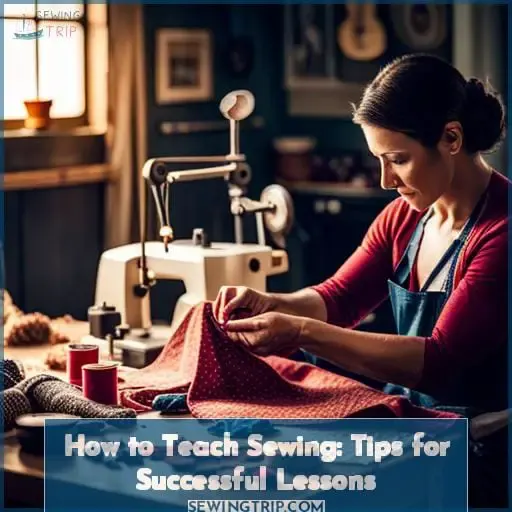 Imagine the satisfaction of teaching others how to sew. Did you know that sewing can empower individuals, giving them a sense of mastery and creativity?
Imagine the satisfaction of teaching others how to sew. Did you know that sewing can empower individuals, giving them a sense of mastery and creativity?
In this article, we will explore valuable tips for successful sewing lessons. From creating lesson plans and setting up the class space to simplifying instruction and choosing the right projects, you’ll learn everything you need to confidently teach others how to sew.
Get ready for an exciting journey into the world of teaching sewing!
Table Of Contents
- Key Takeaways
- Sewing Lesson Plans
- Setting Up the Class Space
- Managing Class Size and Equipment
- Simplifying Instruction
- Choosing the Right Project
- Teaching Children to Sew
- Benefits of Teaching Children to Sew
- How to Begin Teaching Sewing
- Learning Sequence for Sewing
- Tips for a Successful Sewing Lesson
- Frequently Asked Questions (FAQs)
- Conclusion
Key Takeaways
- Create adaptable lesson plans for different learning paces.
- Carefully plan the class space for efficiency and accessibility.
- Simplify instructions using visual guides and learning tools.
- Match project complexity with students’ skill levels.
Sewing Lesson Plans
When planning your sewing lessons, start by creating adaptable lesson plans that cater to each student’s learning pace.
Incorporate a variety of sewing techniques and projects to ensure skill development and keep students engaged.
Begin with simple exercises like machine control, allowing students to master the basics before progressing to more complex tasks.
Provide clear instructions and supply lists for creative projects that can be completed within the allotted time frame.
Remember to consider beginner machines when designing your lessons, as some students may not have access to advanced equipment.
By prioritizing lesson adaptability and focusing on student progress, you’ll create an empowering environment where mastery of sewing becomes achievable for all.
Setting Up the Class Space
When setting up the class space for your sewing lessons, it’s important to:
- Carefully plan the location and ensure you have access to tables and power sources.
- Once you have determined the class location, set up workstations for sewing, cutting, pinning, and ironing.
This will help create an organized and efficient learning environment where students can easily move between different tasks during their lessons.
Planning the Sewing Class Location
To ensure a smooth and organized sewing lesson, plan the location of your class carefully.
Consider factors such as:
- Venue selection
- Equipment preparation
- Space organization
- Class size considerations
- Location logistics
Set up workstations for sewing, cutting, pinning and ironing to maximize efficiency.
Coordinate with participants to bring their supplies and estimate the number of machines needed.
Organizing Workstations
How can you efficiently organize workstations when setting up the class space for sewing lessons?
Workstation organization is crucial to create a conducive learning environment.
Start by planning the layout and ensuring each workstation has the necessary equipment.
Optimize space by arranging stations for cutting, pinning, ironing, and sewing.
Use teaching techniques like labeling supplies and providing clear instructions to enhance students’ experience.
Managing Class Size and Equipment
When it comes to managing class size, start with a small group of beginners and adjust as needed based on the complexity of the projects and your experience.
Consider providing individual sewing machines for more complex projects and evaluate if additional ironing boards and irons are necessary.
In terms of equipment coordination,
- ask participants to bring their own supplies,
- label and organize your sewing supplies for easy identification,
- arrange sewing machines according to the number of participants,
- estimate the number of machines and irons required, and
- always have extra supplies on hand for unexpected needs.
Class Size Management
To effectively manage the size of your sewing class and ensure a smooth learning experience, carefully consider the following:
- The number of participants
- Their skill levels
This will allow you to tailor your teaching techniques and class activities accordingly. By adapting your lessons to accommodate different skill levels, you can promote student engagement, foster skill development, and maximize lesson adaptability.
Take these factors into account when starting sewing lessons for optimal results.
Supply and Equipment Coordination
Now let’s talk about managing class size and equipment for a successful sewing lesson.
Effective supply management and equipment organization are essential for a smooth classroom setup.
Make sure to:
- Label and organize your sewing tools for easy identification.
- Arrange the sewing machines according to the number of participants.
- Estimate the required number of machines and irons.
- Have extra supplies on hand for unexpected needs.
Simplifying Instruction
To simplify instruction, prepare simplified project instructions and create an instruction cheat sheet for easy reference.
Simplified Instructions are crucial when teaching sewing to beginners. Here are three ways to simplify your sewing lessons:
- Use Visual Guides: Incorporate visual aids such as diagrams, pictures, or videos that demonstrate each step of the process.
- Provide Learning Tools: Offer learning tools like templates or rulers that can assist with measuring and cutting fabric accurately.
3.Lesson Adaptations : Modify lesson plans based on individual student needs by adapting projects according to their skill levels.
By implementing these instructional aids, you’ll be able to effectively teach sewing while ensuring a positive learning experience for your students at your sewing school or in private sewing lessons.With these strategies in place,your beginner sewists will quickly gain mastery over various skills while enjoying fun and rewarding projects.
Choosing the Right Project
When it comes to teaching sewing, choosing the right project is crucial for a successful lesson.
As an experienced instructor, you need to match the complexity of the project with your students’ skill levels.
By selecting achievable projects that can be completed within the class time, you’ll provide a sense of accomplishment and motivate your students to continue learning and improving their sewing skills.
Project Complexity: Matching skill levels
When teaching sewing, it’s important to carefully match the complexity of projects to students’ skill levels.
Assess their skills and progress gradually from simple to more challenging projects.
Engage them with skill-building activities and evaluate their progress through assessment methods like fabric cutting or using a commercial pattern.
Class Space Planning: Location and setup
Ensure efficiency in your sewing lessons by carefully planning the class space location and setup.
Consider factors such as:
- Location selection
- Equipment setup
- Space organization
to create a conducive learning environment.
Manage class size effectively and simplify instruction for optimal results.
Managing Class Size: Equipment coordination
As you plan and organize your sewing lessons, consider managing class size and coordinating necessary equipment.
| Class Size | Equipment Organization |
|---|---|
| Adjust based on project complexity | Label and organize supplies |
Teaching Children to Sew
When it comes to teaching children to sew, it’s important to start with the right sewing machine.
A basic sewing machine is sufficient for beginners, and using an existing one from your closet can work just as well.
Focus on learning and skill development rather than the fanciness of the machine.
Sewing Machine for Kids
To teach children to sew, it’s important to have a sewing machine that’s suitable for their age and skill level.
Child friendly machines provide the perfect platform for young learners to develop their skills.
Consider age considerations when selecting a machine, ensuring it aligns with their abilities.
A child-friendly sewing machine can boost confidence and empower kids as they embark on creative sewing projects.
Speed control features are essential in helping them learn at their own pace.
Happy sewing!
Ideal Age to Teach Sewing
When is the ideal age to start teaching children to sew?
The ideal age for teaching sewing is around 6 years old and above. However, it’s important to consider attention spans based on their age and adjust your teaching methods accordingly. Younger children may require more assistance in reading and measuring. By starting early, you can guide them through a learning progression that fosters skill development while keeping them engaged in the process of mastering this valuable craft.
Benefits of Teaching Children to Sew
As a sewing teacher, you have the opportunity to instill valuable skills in children through teaching them how to sew.
Sewing helps develop patience and resilience as they learn new techniques and work on their projects.
Additionally, it introduces math concepts through fabric measurements and improves essential motor skills in both boys and girls.
By teaching children to sew, you aren’t only fostering their creativity but also boosting their self-confidence as they complete sewing projects successfully.
Skill development through sewing
Teaching children to sew offers a range of benefits, as they develop essential skills through the art of stitching.
From project selection to class setup and lesson planning, sewing provides an avenue for skill development in young minds.
Boosting self-confidence
One of the benefits of teaching children to sew is that it boosts their self-confidence as they complete sewing projects.
This boost in self-confidence comes from:
- Engaging in creative projects
- Developing new skills
- Participating in confidence-building activities that encourage creativity
Encouraging creativity
Encouraging creativity in children is vital for their sewing journey.
Encourage them to explore different fabric choices.
Inspire them with design ideas.
Let their imagination run wild.
Encourage student projects that allow for personal expression.
Provide embellishment ideas to enhance their creations.
How to Begin Teaching Sewing
To get started with teaching sewing, you can begin by advertising your classes locally and keeping them small, with no more than 8 students.
Consider the following tips when starting your sewing lessons:
- Effective Advertising:
Promote creativity in your advertisements to attract aspiring sewists of all ages. Highlight the benefits of learning a valuable life skill and emphasize the fun and satisfaction of creating something unique.
- Age Considerations:
Tailor your teaching approach based on age groups to ensure engagement and understanding. Younger children may require simpler projects or additional assistance, while older students can tackle more complex designs.
- Supply Management:
Make sure you have all necessary supplies readily available for each student to simplify the process for parents or participants who mightn’t have their own equipment yet.
Remember that teaching sewing is about empowering others with a new skill while fostering their creative potential.
Learning Sequence for Sewing
Start by ensuring your proficiency with sewing and machine operation.
The learning sequence for sewing is crucial to guide students through skill progression and age suitability. By following a well-planned sequence, you can maximize teaching benefits and create an effective class setup.
Incorporating instructional aids such as printed project directions or numbered tables adds clarity to the learning process.
Here is an example of a learning sequence for sewing:
| Step | Description |
|---|---|
| 1 | Threading the sewing machine |
| 2 | Practicing straight lines |
| 3 | Sewing curved lines |
| 4 | Introducing topstitching, linings, and projects |
| 5 | Teaching simple hand-sewing techniques |
By starting with basic skills like threading the machine and practicing straight lines, students build confidence in their abilities before progressing to more complex techniques. Introducing different aspects of sewing gradually allows them to master each step along the way.
Remember that every student progresses at their own pace, so adapt your lessons accordingly. With proper planning and organization using this learning sequence approach, you can provide your students with a fulfilling journey towards mastering the art of sewing.
Tips for a Successful Sewing Lesson
Make sure to set up your workstations properly for a successful sewing lesson.
- Create an engaging environment that promotes student engagement.
- Provide effective feedback throughout the lesson to support skill progression.
- Be prepared to troubleshoot any issues that arise during the class.
- Foster a positive and encouraging atmosphere to help build students’ confidence in their sewing abilities.
By setting up your workstations thoughtfully, you’ll create an environment where students feel empowered and motivated to learn. Engaging with them through effective feedback ensures they understand their progress and areas for improvement.
Troubleshooting issues promptly demonstrates your expertise as a teacher while instilling confidence in your students’ ability to overcome challenges. With these tips, you can create successful sewing lessons that not only teach valuable skills but also inspire creativity and mastery of the craft.
Frequently Asked Questions (FAQs)
What are some recommended sewing machine brands for beginners?
For beginners, I recommend sewing machine brands like Brother, Singer, and Janome.
These brands offer user-friendly features and reliable performance to help you master the art of sewing with ease and confidence.
How long should each sewing lesson be?
Each sewing lesson should be tailored to your students’ needs, but a good starting point is 2-3 hours.
This allows for focused instruction and hands-on practice while keeping their enthusiasm high.
What are some common mistakes beginners make when learning to sew?
As a sewing instructor, one common mistake beginners make is rushing through the learning process.
Take your time and embrace each step.
You’ve got this!
How do I choose the right fabric for a sewing project?
When choosing fabric for your sewing project, consider the desired drape, weight, and durability.
Look for fabrics that match your skill level and the project’s complexity.
Experiment with different materials to unleash your creativity and achieve mastery in sewing.
Are there any safety precautions I should take when teaching children to sew?
When teaching children to sew, always thread the needle of safety.
Like a vigilant guardian watching over their journey to mastery, ensure they wear protective gear and use child-friendly tools for a safe and empowering experience.
Conclusion
To give successful sewing lessons, it’s crucial to have:
- Well-planned lesson plans
- A properly set up class space
- Managed class size
- Coordinated necessary supplies and equipment
Simplifying instruction and choosing the right projects for your students’ skill levels and the class space are key factors in ensuring a positive learning experience.
Teaching children to sew can have numerous benefits, including skill development and fostering creativity.
By following these tips and incorporating a learning sequence for sewing, you can confidently begin teaching others how to sew.



